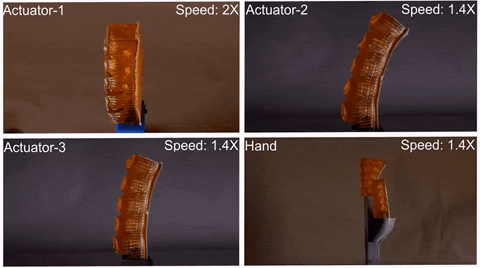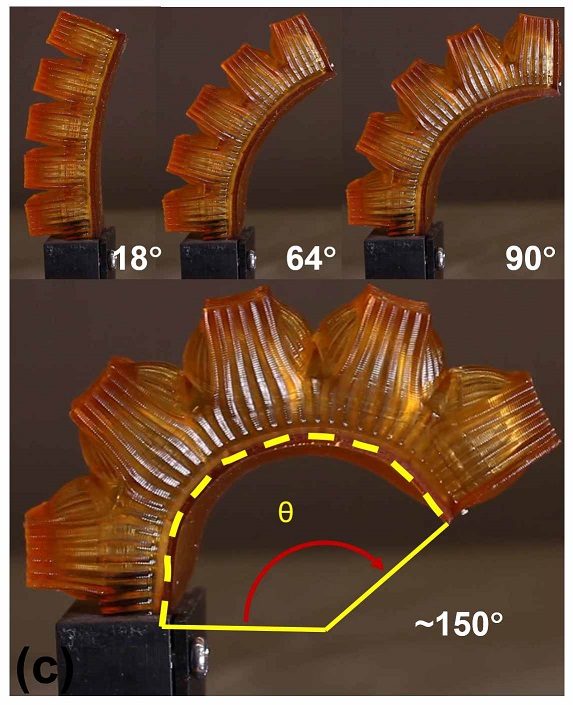This Robot Sweats To Keep Its body Cool, Avoiding Overheating
Dhir Acharya - Feb 01, 2020

This sweating robot resembles animals, releasing water to lower the temperature in its body, allowing it to work for longer without overheating.
- Cafe In Tokyo With Robot Waiters Controlled By Disabled Staff
- Best Robot Vacuums In India To Clean Carpets, Wood Floor And Pet Hair
- AI Is Being Trained To Identify Faces In The Dark Using Thermal Images
A group of international scientists has come up with a soft robotic hand (sweating robot) that perspires when it contacts excess heat. With this innovative concept, we can improve the endurance and durability of robots, making it possible for them to work in severe environments.
The new soft robotic hand was developed by a team including researchers from Italy’s Center for Micro-BioRobotics, Facebook Reality Labs, and Cornell University. The robot manages to keep its body at a stable temperature by releasing sweat through its pores. While the concept is still in an early phase, it shows the potentials for making robots that can work for longer without overheating.

There may have serious problems with robots that have inadequate forms of thermoregulation, no matter if it’s overheating in their components or being sent to extreme environments. Besides, robots with poor cooling strategies can face damages to their durability as well as integrity of materials, not to mention their performance. The new solution is inspired by the cooling powers thanks to perspiration.
Study co-author Thomas Wallin said:

According to Wallin, in the right conditions, an elite marathon runner can lose as much as 3.5 liters of sweat within an hour, equal to 2.4kWatts of energy. Water not only has a low energy level in a thermodynamic system, but its evaporation can also reduce an object’s temperature to below the ambient environment. Meanwhile, other dissipation processes including radiation, convection, and conduction only work in an environment that’s cooler than the robot’s body.

With this in mind, the scientists developed a robot that resembles a balloon with a design that leaks water when its temperature goes higher than a threshold. The robot was made with 3D-printed fluidic actuators from poly-N-isopropylacrylamide (PNIPAm). The actuators, which look like fingers, held water in its lower layer that absorbed heat when it’s filled. Meanwhile, the top layer had micropores that allowed for leaking water.
As PNIPAm reacts to temperature, the robot didn’t need sensors or other components. The pores stayed closed under 30 degrees C, but the micropores expanded when the temperature went higher and the pressurized fluid could trickle out.
Talking to Gizmodo, Wallin said:


Tests showed that the cooling rate of the sweating robots was six times better than the non-sweating controls. By measurements, the study found that the sweating actuators had a thermoregulatory performance exceeding the evaporative cooling capacity of the best systems of animals. The robotic fingers could also wrap around and cool various heated objects. Wallin said:

He said that the new solution will ultimately be used for robots that can work for long time periods without the risk of overheating.
But the researchers also saw limitations in the sweating robot. When the actuators were wet, they were slippery, making grasping difficult. Besides, the bots steadily leaked fluid and ended up running out of water. Right now, the research team is looking to solve these problems, but if the water supply were limited, the robots could just “drink” at a refilling station.
There’s another problem with the sweating robot, loss of efficiency and unexpected leaking. Wallin stated:

In the end, the concept is about getting rid of the bulky, heavy, expensive internal components like radiators and cooling fans for robots. The design is also physically flexible, which is suitable to use in soft robots.
>>> A Walking 18-Meter Gundam Robot Is Being Built In Japan
Featured Stories

Features - Jul 01, 2025
What Are The Fastest Passenger Vehicles Ever Created?

Features - Jun 25, 2025
Japan Hydrogen Breakthrough: Scientists Crack the Clean Energy Code with...

ICT News - Jun 25, 2025
AI Intimidation Tactics: CEOs Turn Flawed Technology Into Employee Fear Machine

Review - Jun 25, 2025
Windows 11 Problems: Is Microsoft's "Best" OS Actually Getting Worse?

Features - Jun 22, 2025
Telegram Founder Pavel Durov Plans to Split $14 Billion Fortune Among 106 Children

ICT News - Jun 22, 2025
Neuralink Telepathy Chip Enables Quadriplegic Rob Greiner to Control Games with...

Features - Jun 21, 2025
This Over $100 Bottle Has Nothing But Fresh Air Inside

Features - Jun 18, 2025
Best Mobile VPN Apps for Gaming 2025: Complete Guide

Features - Jun 18, 2025
A Math Formula Tells Us How Long Everything Will Live

Features - Jun 16, 2025
Comments
Sort by Newest | Popular